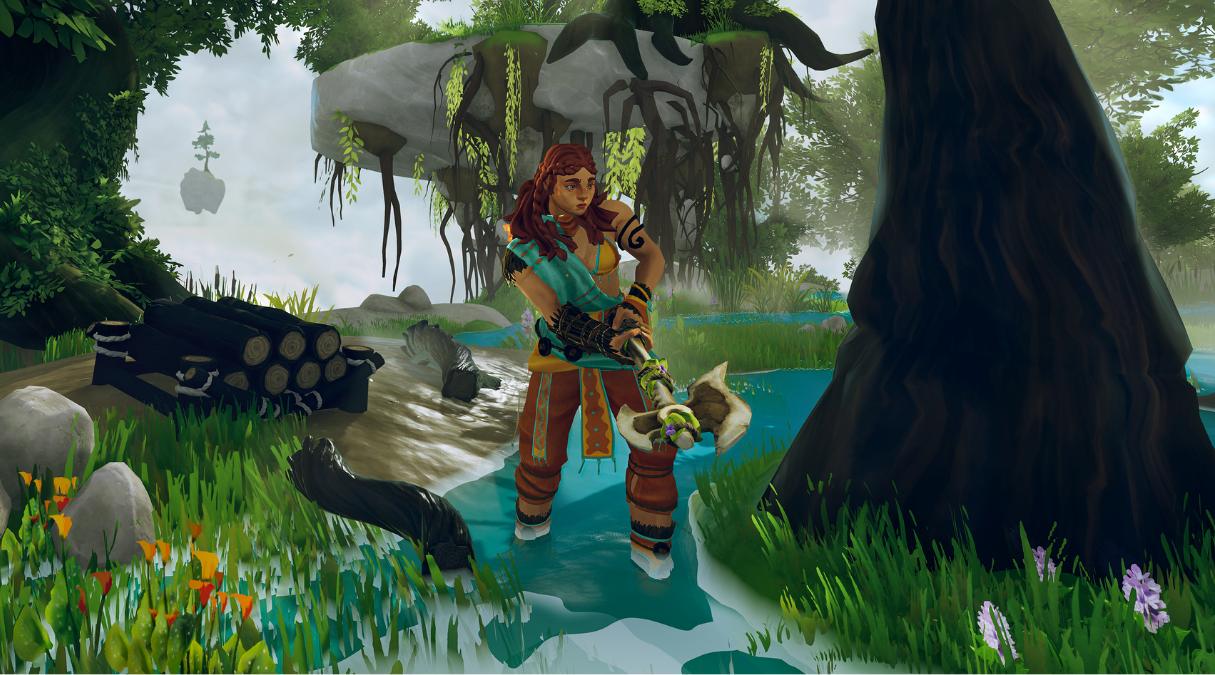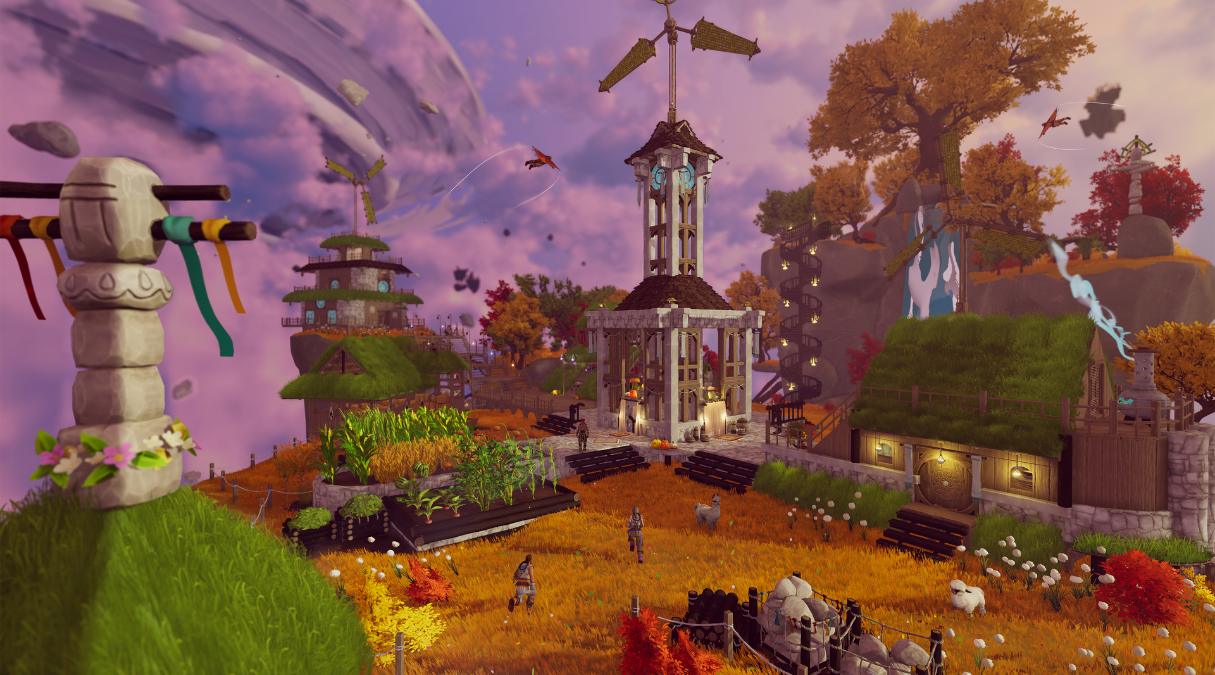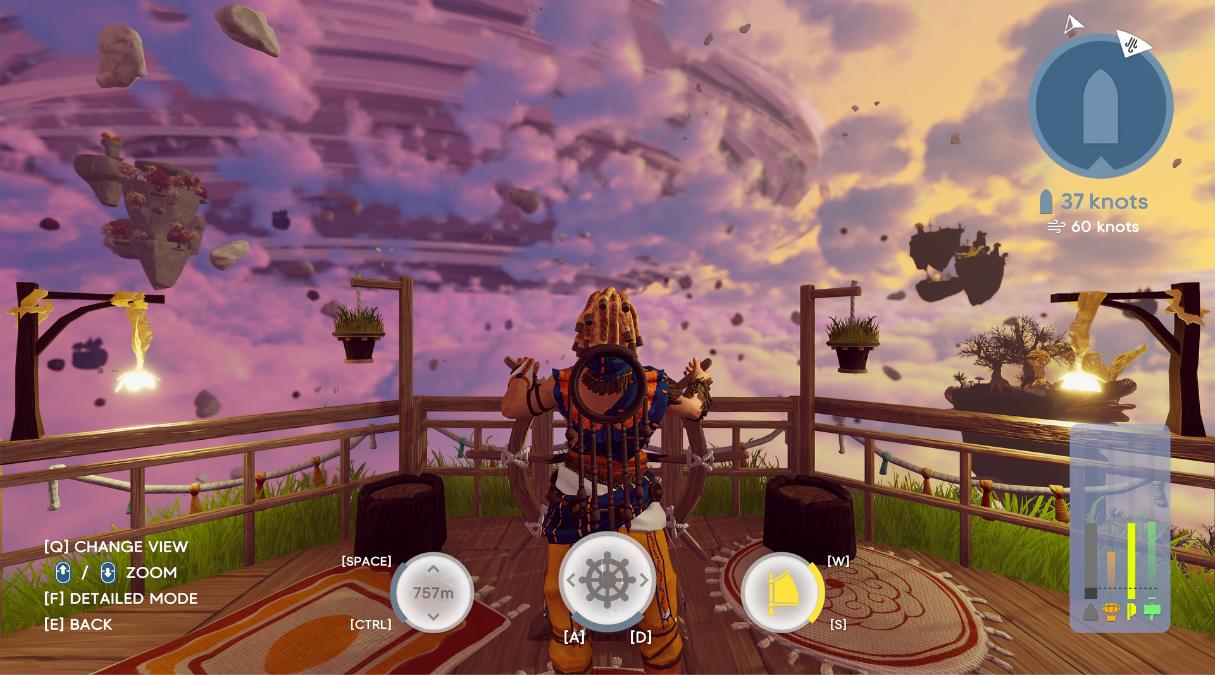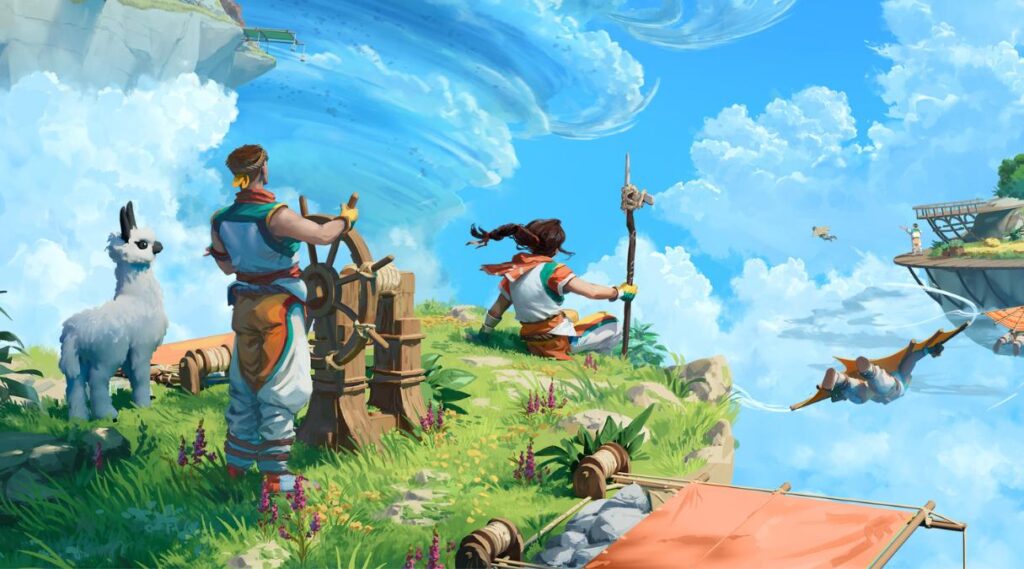A sandbox survival game set in a world of floating islands, Aloft is developed by Astrolabe Interactive and published by Funcom. In the game, you explore floating islands by sailing your skyship. Inventively, the skyship is an island you turn into a boat. On the island, you can build the base of your dreams and keep and raise animals like alpacas, sheep, goats, and pheasants. You can farm, cook, and get as creative as you wish.
As you explore, you also fight corruption that has taken hold on some islands, restoring the environment once it has been defeated. Aloft’s exploration also has a sharp focus on healing the islands’ ecosystems and keeping them in balance.
By using a field guide, you can ensure flora and fauna diversity, clean up invasive species, and more. Each choice you make, whether collecting on the island or curing it of corruption, impacts the island’s sustainability and ability to produce resources. If the island is corrupted or does not have an ecosystem at 100%, you can’t interact with it, harvesting, learning, or even opening chests. As you find new islands, you also have the chance to unlock new technologies and resources.
The final goal in Aloft, however, is to reach the Leviathan. A huge flying creature that is covered with corruption, healing the corruption is your primary mission. Research corruption samples and brew an antidote, fight the corruption, and heal the creature. While the game’s main priority is around 25-30 hours of playtime, the sandbox nature of Aloft allows you to play for much longer, especially as you invest time in building.
Even with tutorials turned on, Aloft doesn’t hold your hand when it comes to its systems. The game will give you suggestions, but there aren’t laid-out legends for icons used in the game’s map or even for the animals. Much of it has to be intuited by playing. Additionally, with the crafting and cooking system based on combining different resources and learning what can happen, it can take quite a while to discover precisely what you need to step up the next rung on the materials you use.
Aloft is a co-op survival game that is light on survival and all-in on exploration.

While this is pretty standard for the survival genre, it’s sometimes difficult. This is primarily because when it comes to survival, you don’t really have to manage any of your stats. I didn’t sleep unless I was close to death. I didn’t need to manage my stamina, and the wet debuff made very little difference in my exploration. Because Aloft doesn’t invest too heavily in survival aspects that negatively impact your play, it’s easy to ignore them. At the same time, it makes it hard to see the game as anything other than something cozy and makes me expect more thorough tutorialization.
That said, one element that works the best and ensures that you can move through the building system at your own pace is the sketchbook. And it’s the game’s smartest innovation as a mechanic. Once you make a sketchbook and find or make paper to fill it, you can equip it to your toolbar and learn the blueprint for anything you see on the islands. As you explore, you’ll come across islands with ruins. Some are vast structures that rival cathedrals, some are all small huts, and even more are just tiny pieces of comfort like a large campfire with seats around it.
With the sketchbook, you can learn just about everything, which allows you to accelerate your building ability. It’s exciting, and it can also unlock designs that you can keep in mind as you build your bases larger. For me, being able to see the different types of furniture that would be available down the road helped me lay out a vision for something larger. This is especially true when it comes to decorations.
Additionally, the building system allows you to upgrade each material as you move through the game if you want to change your aesthetic. By creatively using items for different purposes, you can build intricate structures the more time you put into it. Building was the central joy in my time with Aloft. It’s where I focused all my energy, invested my resources, and constantly worked to improve.
The fact that you can build down and around your floating island makes base-building the most entertaining element. It also gives you a focal point for using your collected resources. I note that because collecting base resources is extremely easy to collect, you usually always have excess materials. While resources like stone, wood, grass, and small plants are extremely easy to find and collect, other resources like wool rely on the animals you raise or the ones you find. Wool is also necessary for stronger sails, the same with linen, which makes stockpiling them high before you travel essential as you head into a larger storm.
Aloft’s building system allows for near-endless creativity.

One other element that makes the building so immersive is Aloft’s score. Aloft has one of the best video game scores I’ve heard in quite some time. The engrossing and atmospheric music lulls us into comfort. It’s the key component to allowing you to lose hours just creating buildings and harvesting resources.
As you traverse the world, the greatest danger you face is mostly your sails breaking. Playing in co-op with a partner makes it easy to have someone steer the ship while the other person repairs the sails as they fail to keep moving forward. That said, managing sail upkeep is hard when it’s just you. Once you fix one, another starts breaking, and moving forward is extremely difficult in ways that make it so that I’m not sure I would play alone.
Aloft’s largest issue with gameplay is that the world is too expansive, feeling empty. While sandbox survival games need to have a variety of ways to play and large zones to explore, Aloft doesn’t do well at balancing its expansive world with things to do in it.
Once you pick your head up from building, the exploration grows repetitive. The biomes feel more like changing seasons, which doesn’t add too much variety, and if you’ve been using your sketchbook thoroughly enough, the anchors and knowledge stones you encounter don’t give you anything.
With a small number of animals and an even smaller number of combat enemies, the game loop feels like it’s closing in, not expanding. The longer I played, the less I needed to keep exploring. The only thing I kept pursuing as I hopped across islands was the deep need for flax so that I could finally make linen and explore some of the more interesting furniture designs and clothing.

But outside of that, I knew the corruption I would fight would be the same as in the last zone. I would step onto an island knowing that the animals would just be different variations with potentially cuter names. And ultimately, unless the island had something to learn from (and sometimes even if it did have an anchor), the island was a quick pitstop just to leave almost immediately.
Aloft is ambitious regarding its world creation, but navigating when you consistently encounter the same combat and items and can’t pick up any new designs can be overwhelming. If the sandbox had been condensed, it would have been hard for it to feel empty. Instead, I want more to do. I want exploration to make sense and feel like it matters. Right now, we’re just floating along instead of moving with intention.
Outside of this, the game has a litany of technical issues that show themselves the most when you land on corrupted islands, switch zones, or head into storms. You can avoid most of it if you do nothing but stay at your base or avoid steering the ship while your co-op partner does. But even then, that’s an equitable experience.
Aloft is an ambitious undertaking of a game. There is a lot here with one to eight-person co-op, an island editor (which I could not use in the current build), a vast world, and a really engrossing building system with over 600 parts to play with. However, with technical issues, a repetitive game loop, and too much empty space, early access feels like missing essential elements that help create longevity. That said, if the team can smooth out the jagged edges, Aloft can reach its potential.
Aloft enters early access on PC via Steam starting January 15, 2025.








